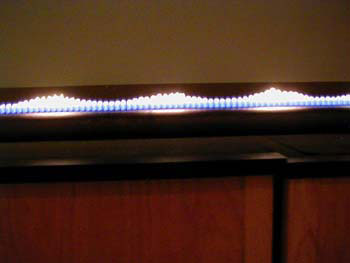Demos: 4B-01 Standing Waves in a Gas

An acoustic standing wave is established in a gas that is flammable. Holes equally spaced at the top of the tube allow the gas to be ignited. Under static conditions, the gas pressure is uniform and since the holes are uniform, the flame tips are uniform in height across the length of the tube. However, when a standing wave of sound is set up, the tube has an alternating pattern of high and low pressures, causing the flame heights to vary. A pattern of wave crests can be seen across the top of the tube. The spacing of the crests depends on the frequency of the sound wave.
Directions: Make sure any overhead projectors adjacent to this apparatus are moved or turned off. The fan can extinguish the flame! First light the Bunsen burner, the open the line from the gas jet. Wait about ten seconds or so until the gas has displaced the air in the tube. Then pass the bunsen burner back and forth along the top of the tube until all the holes are lighted. Turn on the amplifier that drives the signal generator. Adjust the volume until you see a reasonable variation in the flame height. Then use the frequency knob to change the frequency of the source. Moving the frequency up and down quickly will produce a “siren” effect and the movement of the flame tips is impressive!
Note: Ask the lecture-demo technician about the possibility of sending the output from a Boom Box playing loud rock music into the speaker. Interesting flame patterns can arise and it surely is entertaining to watch!
Suggestions for Presentation: Light the tube as described above. Ask why the flame tips are all the same height. What does this imply about the pressure? In a standing wave in a gas, there are regions of low and high pressure. Which are which, i.e. which are the nodes and which are the antinodes? How would this affect the flame?
Applications: Flame tips can be used to monitor pressure variations in a gas.
Last Updated: Nov 30, 2023 11:25 AM